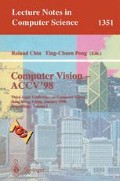Abstract
Obstacle avoidance is a major requirement for any technological aid aimed at helping partially sighted (TAPS) people to navigate safely. In this paper, a stereo vision-based algorithm (Ground Plane Obstacle Detection) is extended to detect small obstacles for TAPS using RANSAC dynamic recalibration and Kalman Filtering. Obstacle detection and false alarm are investigated probabilistically. Furthermore, a technique is developed to find objects by matching their edges with some heuristic criteria. Experiments show that obstacle edges are extracted much better with our dynamic recalibration approach and that objects can be found successfully by the edge matching technique.
Preview
Unable to display preview. Download preview PDF.
References
Y. Bar-Shalom and T.E. Fortmann. Tracking and data association. Academic Press, Boston, London, 1988.
I.J. Cox. A review of statistical data association techniques for motion correspondence. International Journal of Computer Vision, 10(1):53–66, February 1993.
F. Ferrari, E. Grosso, G. Sandini, and M. Magrassi. A stereo vision system for real time obstacle avoidance in unknown environment. In Proceedings of IEEE International Workshop on Intelligent Robots and Systems IROS '90, pages 703–708, 1990.
M.A. Fischler and R.C. Bolles. Random sample consensus: a paradigm for model fitting with application to image analysis and automated cartography. Commun. Assoc. Comp. Mach., 24:381–395, 1981.
B.K.P. Horn. Robot Vision. The MIT Press, 1986.
D. Lee. The movement of sensors carried on the trunk of a walling person. Oxford University, January 1996.
F. Li. Visual control of AGV obstacle avoidance. DPhil First Year Report, Department of Engineering Science, University of Oxford, 1994.
F. Li, J.M. Brady, I. Reid, and H. Hu. Parallel image processing for object tracking using disparity information. In Second Asian Conference on Computer Vision ACCV '95, pages 762–766, Singapore, December 1995.
L. Matthies and P. Grandjean. Stochastic performance modeling and evaluation of obstacle detectability with imaging range sensors. IEEE Trans. on Robotics and Automation, 10(6):783–792, 1994.
J.E.W. Mayhew, Y. Zheng, and S. Cornell. The adaptive control of a four-degreesof-freedom stereo camera head. In H.B. Barlow, J.P. Frisby, A. Horridge, and M.A. Jeeves, editors, Natural and Artificial Low-level Seeing Systems, pages 63–74. The Royal Society, London, 1992.
N. Molton. Egomotion recovery from stereo. DPhil First Year Report, Department of Engineering Science, University of Oxford, 1996.
N. Molton, S. Se, J.M. Brady, D. Lee, and P. Probert. A stereo vision-based aid for the visually impaired. Image and Vision Computing, 1997. to appear.
S.B. Pollard, J.E.W. Mayhew, and J.P. Frisby. Implementation details of the pmf stereo algorithm. In J.E.W. Mayhew and J.P. Frisby, editors, 3D Model Recognition From Stereoscopic Cues, pages 33–39. MIT, 1991.
S.B. Pollard, J. Porrill, J.E.W. Mayhew, and J.P. Frisby. Disparity gradient, lipschitz continuity, and computing binouclar correspondences. In J.E.W. Mayhew and J.P. Frisby, editors, 3D Model Recognition From Stereoscopic Cues, pages 25–32. MIT, 1991.
S. Se. Visual aids for the blind. DPhil First Year Report, Department of Engineering Science, University of Oxford, 1996.
S. Se and M. Brady. Vision-based detection of kerbs and steps. In Eighth British Machine Vision Conference BMVC '97, pages 410–419, September 1997.
Z. Zhang and O. Faugeras. 3D Dynamic Scene Analysis. Springer-Verlag, 1992.
Author information
Authors and Affiliations
Editor information
Rights and permissions
Copyright information
© 1997 Springer-Verlag Berlin Heidelberg
About this paper
Cite this paper
Se, S., Brady, M. (1997). Stereo vision-based obstacle detection for partially sighted people. In: Chin, R., Pong, TC. (eds) Computer Vision — ACCV'98. ACCV 1998. Lecture Notes in Computer Science, vol 1351. Springer, Berlin, Heidelberg. https://doi.org/10.1007/3-540-63930-6_116
Download citation
DOI: https://doi.org/10.1007/3-540-63930-6_116
Published:
Publisher Name: Springer, Berlin, Heidelberg
Print ISBN: 978-3-540-63930-5
Online ISBN: 978-3-540-69669-8
eBook Packages: Springer Book Archive

